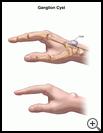
Ganglion Cyst
________________________________________________________________________
KEY POINTS
- A ganglion cyst is a fluid-filled sac under the skin caused by a buildup of fluid due to irritation, injury, overuse, or repetitive motion.
- Sometimes cysts go away without treatment. If the cyst is painful or causing problems, you may need to have fluid removed, or have the cyst removed.
- Avoid activities or exercises that irritate the area with the cyst. Ask your healthcare provider when you can return to your normal activities.
________________________________________________________________________
What is a ganglion cyst?
A ganglion cyst is a fluid-filled sac under the skin. The sac grows out of the tissue that surrounds a joint or to the covering over a tendon. Tendons are strong bands of tissue that attach muscle to bone. A sheath, or covering, surrounds the tendons. The cyst can be the size of a small pea or as large as a golf ball. Ganglion cysts are most often on the wrist or hand, but may also be on the foot.
What is the cause?
A ganglion cyst may be caused by a buildup of fluid due to irritation, injury, overuse, or repetitive motion.
What are the symptoms?
Symptoms may include:
- Pain
- Swelling that may get better and then worse again
- A lump that gets bigger over time
- Trouble moving the area near the cyst
How is it diagnosed?
Your healthcare provider will ask about your symptoms and medical history and examine you.
You may have tests such as:
- Aspiration, where your provider uses a needle to take a sample of the fluid from the cyst. The fluid can be tested for problems, such as infection.
- An ultrasound, which uses sound waves to show pictures of the cyst
- MRI, which uses a strong magnetic field and radio waves to show detailed pictures of the cyst.
How is it treated?
Sometimes cysts go away without treatment. If the cyst is painful or causing problems, your healthcare provider may:
- Remove fluid from the cyst with a needle to reduce swelling
- Inject steroid medicine into the cyst to prevent recurrence
- Remove the cyst with surgery
Even with surgical treatment, a cyst may come back.
How can I take care of myself?
Follow the full course of treatment prescribed by your healthcare provider. If the cyst is painful:
- Put an ice pack, gel pack, or package of frozen vegetables wrapped in a cloth on the area for up to 20 minutes at a time every 3 to 4 hours, or at least once daily, until it gets less painful.
- Take nonprescription pain medicine, such as acetaminophen, ibuprofen, or naproxen. Read the label and take as directed. Unless recommended by your healthcare provider, you should not take these medicines for more than 10 days.
- Nonsteroidal anti-inflammatory medicines (NSAIDs), such as ibuprofen, naproxen, and aspirin, may cause stomach bleeding and other problems. These risks increase with age.
- Acetaminophen may cause liver damage or other problems. Unless recommended by your provider, don't take more than 3000 milligrams (mg) in 24 hours. To make sure you don’t take too much, check other medicines you take to see if they also contain acetaminophen. Ask your provider if you need to avoid drinking alcohol while taking this medicine.
- Avoid activities or exercises that irritate the area with the cyst
Ask your provider:
- How and when you will get your test results
- How long it will take to recover
- If there are activities you should avoid and when you can return to your normal activities
- How to take care of yourself at home
- What symptoms or problems you should watch for and what to do if you have them
Make sure you know when you should come back for a checkup. Keep all appointments for provider visits or tests.
When can I return to my sport or activity?
The goal of rehabilitation is to return you to your sport or activity as soon as is safely possible. If you return too soon you may worsen your injury, which could lead to permanent damage. Everyone recovers from injury at a different rate. How soon you can return to your sport will be measured by how soon your joint recovers, not by how many days or weeks it has been since your injury occurred. In general, the longer you have symptoms before you start treatment, the longer it will take to get better.
If you have a wrist ganglion, you may return to your sport or activity when you can do your activities without pain. You may need to wear a wrist brace or have your wrist taped. In sports such as gymnastics, you will not be able to participate fully until you can bear weight on your wrist while tumbling without pain. In sports such as baseball or tennis, it is important that your wrist does not hurt when you are holding the bat or racquet while doing your swing.

